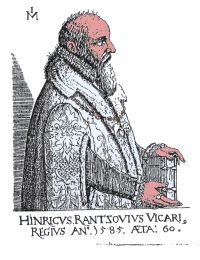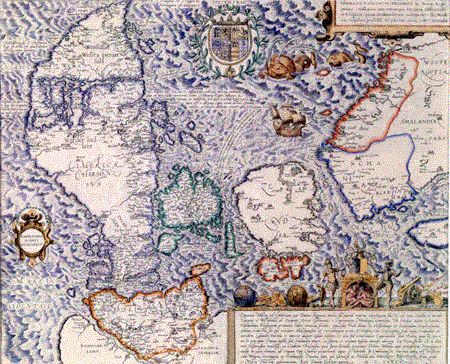
Henrik Rantzau (1526-1599)

Some of the books published about Henrik Rantzau.
* W. Lorentzen, about his castles and manors, based upon the "Rantzau Table".
* O. Brand, about his diplomatic activities.
* W. Steinmetz, about his artistic activities.
* The Schleswig-Holstein State Archive, for commemorating his death, 400 years ago.
* D. Lohmeier, on humanism and renaissance.
* Hjördis Jahneke has recently written a thesis about its architecture and its gardens.
There are newer developments also in 2004
* Dr Günther Oestmann wrote; "Heinrich Rantzau und die Astrologie"
* Peter Zeeberg, a Danish latinist who ao translated Saxo's Denmark history into modern Danish, published;
"Heinrich Rantzau, A Bibliography"
For me it is fun to discover small inaccuracies in these publications.
For example, in Lohmeier's book it says on page 16 that the"Rantzau Table" is to be found at Krengerup, while it is at Rosenvold castle. In fact, there the photograph was taken for the exhibition at the State Archive.
To the picture on page 44 it can be mentioned that it most likely is a copy of an earlier one, because in one of the Rantzau shields, the right one, the colour is shifted to the wrong side. Presumably because of the mirror effect between woodcut and print. Even though, it is interesting to see how well faces and armour are copied
To the picture on page 45 can be added that the armour Henrik is wearing is identical to the armour of William of Orange on a picture by Goltzius from 1581. Obviously Goltzius is using a design he is familiar with, either from an earlier engraving, or because he owned this armour.
On page 98, 1588 is mentioned for the 2nd edition of the Genealogia Ranzoviana, this should be 1587.
There are other things which are fun to observe on these pictures. At the Plantijn printing office at Antwerp, they used their own woodcut, dated in 1574, for a 1581 book. For their 1585 3rd edition printing of "De conservanda" they used the same block. However, the size of the book was now not large enough to fit the complete picture, so they simply cut off the pillars with the shields! Even then they did not include the 1580 Elephant order, so it is clear that Henrik did not have any influence on such printings.
Henrik studied at Wittenberg, under Luther and Melanchton, and was one, or thé most influential man to introduce the Renaissance and Humanistic thoughts in Schleswig- Holstein. He could do so because, unlike his father who still was one of the fighting Rantzau's, he was the first bureaucrat, diplomat and maecenas of the family. Though still in armour, he carries a document instead of a sword on his pictures.
These attitudes he must have acquired during his studies, and at the court of Charles V from 1548 until 1550. His "networking" there no doubt supplied him with a lot of the contacts he later used in his diplomatic efforts for the Danish Kings.
He was a famous contributor to Braun and Hoogenberg's Civitates Orbis Terrarum, an atlas of some 530 European cities from around 1595 where he supplied the Scandinavian and Schleswig-Holstein part. As an indication of his influence it might be mentioned that it contains only óne country map; of Denmark
 highlighting the exploits of Henrik's father Johan.
highlighting the exploits of Henrik's father Johan.
For a Dutchman it is very tempting to think he was influenced by Prince William of Orange who was at the Brussel's court from 1544-1553. (Not the William still remembered in Northern Ireland)